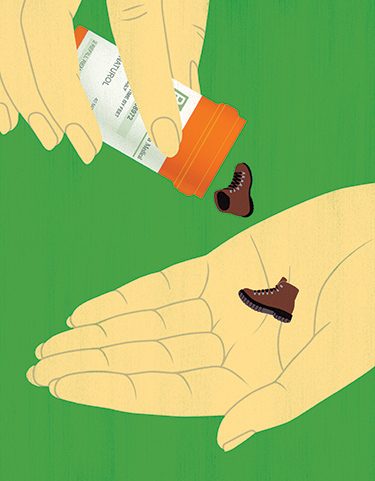Time outdoors is a natural elixir. Researchers still don’t know why.
 At least two decades of research confirms what might seem obvious for many residents of the Pacific Northwest: time in nature is good for you. It can lower blood pressure, alleviate depression and anxiety, and even reduce nearsightedness in children.
At least two decades of research confirms what might seem obvious for many residents of the Pacific Northwest: time in nature is good for you. It can lower blood pressure, alleviate depression and anxiety, and even reduce nearsightedness in children.
But how often should you interact with the natural world? Where? And for how long? Is gazing at the stars from your backyard enough to reap rewards? Would a solitary, seven-day backpacking trip in the Cascades yield greater results?
Can you really take two hikes and call the doctor in the morning?
A wide-ranging team of researchers at the University of Washington hopes to answer many of these questions through the Nature for Health initiative. The effort, launched in October with a $1 million grant from outdoor retailer REI, brings specialists from disciplines including ecology, urban planning, public health, geography and the visual arts together with pediatricians, child-care providers and mental-health professionals.
This diverse group has one common goal: to understand why and how an afternoon skipping rocks at the beach, for example, or walking through a field bursting with wildflowers is beneficial for our health. Their research will focus on nature’s effects on the health of children, veterans, seniors, health-care providers and underserved communities.
With screen time on the rise and time outside in decline, UW researchers hope their work will give policymakers, teachers, doctors and parents a well of evidence to draw from when designing schools, parks and treatments—or just planning a Saturday.
“The more we know about the reasons we get these benefits—is it the lack of people, is it the quiet, is it visual cues or smells, is it the chemicals coming from the trees—the better we can describe the kind of outdoor experience you need,” says Joshua Lawler, an ecologist and lead Nature for Health researcher, whose own office at the School of Environmental and Forest Sciences is filled with greenery. Ivy drapes down his bookshelves and potted ferns sit atop his desk.
About a year ago, Lawler made a personal calculation about the relative benefits of exposure to nature. Then he traded a short commute to the Seattle campus from Wedgwood for 5 acres on Vashon Island. From his new home, he walks to the water with his boys, ages 8 and 12, and watches sea lions play near the shore. Twice so far on his way to work, the ferry stopped for a passing pod of orcas.
His is a life built around the greens and blues of the Puget Sound—something he realizes not everybody can have or would necessarily want. And, in many cases, nature on a grand scale may not be required.
Children should be inspired to explore small patches of nearby nature, says pediatrician Pooja Tandon, ’10. Tandon is an assistant professor at the UW, a member of Seattle Children’s Research Institute and part of the Nature for Health team. Working with Best Start Washington, a Seattle nonprofit focused on improving children’s health, she helped design a program to encourage outdoor play.
During checkups, pediatricians hand their tiny patients age-appropriate toys to play with outside: sidewalk chalk for a 1-year-old or a kite for a 3-year-old. The gifts create a moment for parents, children and their doctors to talk about making nature play a regular event. “Unless there’s evidence and some sort of priority given to these things that feel so intuitive and obvious, I think they can get lost,” Tandon says.
Some Washington doctors are already suggesting doses of nature to their adult patients to treat conditions ranging from heart disease to depression. Berdi Safford, a doctor in Ferndale, recently started giving out “parkscriptions”—prescriptions for spending time outdoors. A new park-finding app created by Recreation Northwest, a nonprofit in Whatcom County, helps her and other medical providers identify parks and trails near patients’ homes.
Safford moved to Seattle in 1970 for a mountain-climbing class and ended up enrolling in medical school at the UW. She is a lifelong advocate for outdoor time. She grew up in New Hampshire and spent family vacations in the White Mountains.
But persuading her patients to embrace outdoor workouts, especially in the cold and rain, is often a tough sell. Many of Safford’s patients at the Ferndale Family Medical Center, a federally designated rural health clinic, are low-income and do not have the time or money for ski trips or mountain bikes.
Even suggesting an inexpensive alternative like walking close to home can be complicated, says Safford. That’s especially true in Ferndale, she says, where a good number of her patients live on rural roads with deep drainage ditches, no sidewalks and cars rushing by at 50 mph.
By providing specific spots to safely enjoy nature, Safford hopes the parkscriptions will remove at least one obstacle between her patients and the fresh air. “Houses are full of exercise equipment that doesn’t get used,” Safford, ’76, says. Parks offer an “added benefit of seeing other people, being out in nature. It’s just so much nicer.”